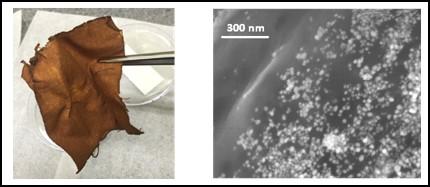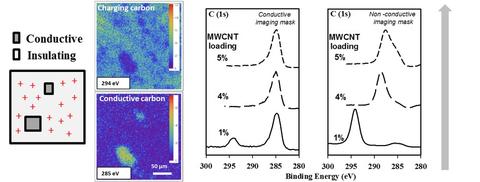Completed Research Projects
Nanomaterials are used in new and existing consumer products for improved physicochemical properties such as mechanical strength (e.g. MWCNT) and antimicrobial activity (e.g. AgNP). As a result, they have been added to multiple consumer products in industries ranging from textiles, composites, electronics and more. In order to optimize the use of nanomaterials from an economic standpoint and from and environmental safety standpoint, measurement methods and characterization strategies are needed as well as data on transformation of nanomaterials once incorporated into products throughout their lifecycle. To address these needs, my research has focused on the following: developing model systems in the characterization of AgNP loaded textiles; improving surface chemical analysis methods to better characterize nanomaterials in consumer products; investigate how nanomaterials transform in natural and laboratory settings; and contribute towards the development of nanomaterial standards.
Quick links to project descriptions and more
- Developing AgNP loaded textile test materials as control samples
- X-ray Photoelectron Spectroscopy (XPS) method development: Surface chemical detection of MWCNT in polymer composites
- Photo-oxidation of citrate AgNP suspensions
- Impact of Storage Conditions on the physical and chemical stability of citrate stabilized AgNP suspensions
- Reference Material Development: RM 8017: 75 nm PVP Stabilized AgNP
1. Nano-enabled consumer products

A major issue in measuring and characterizing nano-enabled consumer products of unknown composition is having well characterized, known controls reflective of the system that one is trying to study and methods for finding individual nanoparticles. To address this problem, we have developed a methodology for loading AgNP onto cotton threads which involves synthesizing nominally 20 nm AgNP in the presence of a set mass of cotton threads or textiles. Spectroscopic measurements (XPS, ICP-MS) found that silver was successfully loaded onto the threads and microscopy (SEM/AFM) revealed that the silver loaded was on the nanoscale. Additionally, a guidance document was prepared evaluating approaches for particle size analysis in textile surfaces. However challenges remained in providing reproducible AgNP diameter measurements on particle size due to irregular surface morphology, poor sample conductivity and limits of instrumental detection.
Ongoing studies focus on varying the synthesis used to load AgNP onto the textile to increase the nanoparticle diameter as well as on different textile materials to make the test materials relevant to a wider range of consumer products. Also, evaluations of commonly used instruments detection limits will be evaluated, both from a surface silver concentration and particle diameter perspective when characterizing AgNP on the surface of textiles. Lastly, use of the developed textile control in conjunction with nanosilver enabled consumer products are being evaluated throughout their life cycle of use. This research has been performed in collaboration with the Chemical Sciences Division.
- Gorham et al. “Preparation of silver nanoparticle loaded cotton threads to facilitate measurement development for textile applications”. NIST SP 1200-8 2015
- Underwood and Gorham "Challenges and approaches for particle size analysis on micrographs of particles loaded onto textile surfaces" NIST SP 1200-22 2017
b. X-ray Photoelectron Spectroscopy (XPS) method development: Surface chemical detection of MWCNT in polymer composites

Being able to characterize the distribution of nanomaterials throughout the surface and bulk of nano-enabled materials is necessary to assess environmental and toxicological risks associated with it before and after use. Specifically, detecting the presence of nanomaterials at the surface of nano-enabled products is especially important since that is where the material will be most likely to interface with its surrounding environment. XPS is well suited towards to the task of surface chemical characterization as it is highly surface sensitive technique (analysis depth ≈ 10 nm). However, in the example of MWCNT-polymer composites, this can be quite challenging due to the irregular topography, electronically disparate components, and overlapping spectral features in XPS. Our research has demonstrated a novel approach to qualitative detection of surface MWCNTs in polymer composites by allowing the photoelectron intensity from the more insulating polymer to separate from the photoelectron intensity from conductive MWCNTs in a phenomenon more commonly referred to as ‘differential charging’. This approach has been employed in multiple research projects including most recently in a study which employed XPS imaging and differential charging to identify the dispersion properties of MWCNTs in an epoxy matrix. Ongoing research will investigate ways of making this qualitative method for the detection of surface MWCNT species by XPS and XPS imaging more quantitative. Various aspects of this research were performed in collaboration with the Biosystems and Biomaterials Division, Materials and Structural Systems Division, Materials Science and Engineering Division, Engineering Physics Division, Johns Hopkins University, and Stoneybrook University.
- Gorham et al “Detecting Carbon in Carbon: Application of Differential Charging to Obtain Information on the Chemical Identity and Spatial Location of Carbon Nanotube Aggregates in Composites by Imaging X-ray Photoelectron Spectroscopy” Carbon 2016
- Goodwin et al “Interactions of Microorganisms with Polymer Nanocomposites Containing Different Loadings of Oxidized Single and Multi-walled Carbon Nanotubes” ES&T 2015
- Gorham et al “Challenges, Strategies and Opportunities for Measuring Carbon Nanotubes within a Polymer Composites by X-ray Photoelectron Spectroscopy” NIST SP 1200-10 2015
- Peterson et al “Impact of UV Irradiation on the Surface Chemistry and Structure of Multiwall Carbon Nanotube Epoxy Nanocomposites” Carbon 2014
- Ging et al. “Development of a conceptual framework for evaluation of nanomaterials release from nanocomposites: environmental and toxicological implications “ STOTEN 2014
2. Environmentally-induced transformations
a. Photo-oxidation of citrate AgNP suspensions
The potential for AgNP to be released into effluents or surface waters from use, washing or disposal of products containing nanosilver raises concerns of an impact on the natural environment. However, to accurately study the impact of AgNP released into the environment, one must first understand how the nanoparticles will transform when exposed to variables such as UV radiation.To that end, we have exposed differently sized, citrate capped AgNP suspensions to UV radiation representative of the high energy component of the sun. Results from optical measurements (UV-Vis) demonstrate that AgNPs transform under UV exposure by losing their metallic, single particle characteristics at a rate linearly dependant upon the specific surface area of the nanoparticles in suspension. Size based analysis (DLS, AFM, TEM) revealed a significant decrease in size along with occasional aggregation. Chemical analysis (XPS, DMT) revealed that the process was dominated by photo-oxidation from metallic silver to oxidized silver and Ag+ along with the development of a core-shell structure (in-situ TEM). Additional tests suggested that enhanced citrate concentrations slowed the rate of photo-oxidation and enhanced the degree of aggregation.
Ultimately, it was determined to be unlikely that AgNPs will remain in unmodified upon entrance into natural waterways, and that they most likely will transform into an oxidized form (Ag(I)). Additionally, the presence of a stabilizers and weak reducing agents may result in retarding the rate of photo-oxidation at higher concentrations. This research was performed in collaboration with the Johns Hopkins University.
b. Impact of Storage Conditions on the physical and chemical stability of citrate stabilized AgNP suspensions
A common practice when working on studies that involve research on the fate & transport or toxicity of AgNP suspensions is to generate a starting stock suspension and to extract samples from the stock to study. Our research explored how AgNPs transformed during storage over the course of > 100 days under a matrix of 36 different storage conditions to determine which were most important. In efforts to provide a benchmark for best practices, we employed basic, commonly available instrumentation to track the stability of the suspensions. Specifically, UV-vis, DLS and H1-NMR were employed to make measurements on single particle stability, size/aggregateion state, and stabilizer concentration, respectively. Results suggested that all stock suspensions stored at low silver concentrations (< 1 mg/L) experienced significant transformations in under a day. At higher concentrations, the impact of light exposure became very important and evidence was found suggesting that the citrate stabilizer broke down as well into smaller organic fragments. Recommendations from this study include the storage of stock suspensions at high silver and citrate concentrations in the absence of light and purged to lower dissolved oxygen content. Additionally, it is recommended to monitor the stock suspension throughout the course of an experiment with baseline measurements to verify ones finding is not due to having a transformed stock suspension. This research was performed in collaboration with the Chemical Sciences Division.
3. Reference material development
a. RM 8017: 75 nm PVP Stabilized AgNP
RM 8017 is the 75 nm poly (vinyl pyrollidone) stabilized AgNP reference material that was completed and made available early in 2015. This reference material provides four size based reference values, reference cumulative size distribution values, and a reference value for mass. Additionally, information values are provided for measurements made on field flow fractionation, single particle ICP-MS, elemental impurities analysis by ICP-MS, endotoxin analysis, TEM imaging, UV-vis spectroscopy, zeta potential and pH. Measurements for this RM have been performed in collaboration with the Chemical Sciences Division, the Materials Science and Engineering Division and the Nanotechnology Characterization Laboratory (NCL) out of the National Cancer Institute (NCI). Click here for more information on how to obtain RM 8017.

